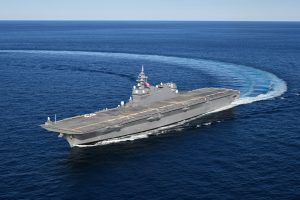The Japan Maritime Self-Defense Force (JMSDF) has announced its helicopter carrier JS Kaga (DDH 184) will conduct on-board operational tests of Lockheed Martin F-35B Lightning II multirole fighter aircraft off the coast of San Diego, California from October 5 to November 18.
With the support of the United States Navy and United States Marine Corps, F-35B fighter aircraft from the Marine Corps will conduct primary tests such as short takeoff, vertical landing, and flight operations from the Kaga, which is being converted into a fully-fledged aircraft carrier capable of enabling F-35B operations.
The landing guidance system for the F35B’s on-board operational test is set to be the Joint Precision Approach and Landing System (JPALS), jointly developed by the U.S. Navy and Raytheon. JPALS is an all-weather landing system that uses Global Positioning System (GPS) satellite signals and an inertial navigation system (INS) to automatically guide military aircraft such as the F35B to land safely and accurately.
Admiral Saito Akira, the chief of staff of the JMSDF, said at a press conference on September 10, “To defend the sea and airspace surrounding our country, including the vast Pacific coast, it is essential to enable [fighter jets] to take off and land on ships at sea.”
“It will improve our defense capabilities and contribute to peace and stability in the Indo-Pacific region,” the JMSDF’s top officer stressed.
The operational tests of the Kaga will be conducted as part of the deployment of the JMSDF’s 4th Surface Unit for the Indo-Pacific Deployment 2024 (IPD24).
About 20 members of the Japan Air Self-Defense Force will also participate in the operational tests.
The JMSDF is currently modifying its two Izumo-class helicopter carriers – JS Izumo and JS Kaga – into light aircraft carriers. The conversion of Japan’s two largest warships into aircraft carriers is aimed at strengthening deterrence against the Chinese military, which is making aggressive advances into the East and South China Seas and the Pacific Ocean.
The two vessels have been modified twice each, taking advantage of the ships’ periodic refit and overhaul programs, which take place every five years.
The Kaga just finished its first major modification at the end of March this year, renovating the bow to a rectangular shape. Part of the ship’s deck also has been made heat-resistant to withstand the heat of aircraft landings.
In October 2021, the JMSDF also conducted takeoff and landing tests of the F-35B on the Izumo, supported by the U.S. Marine Corps. The tests took place off the coast of Shikoku, and F35Bs belonging to the U.S. Marine Corps Air Station Iwakuni participated.
During this fiscal year 2024, as part of its second modification, the Izumo is undergoing the conversion of the bow section of its flight deck from a trapezoid into a square shape. The Kaga underwent the same modifications during fiscal year 2023.
The ministry said the Izumo’s modification is scheduled to be completed in fiscal year 2027, and the Kaga’s in fiscal year 2028.
The two Izumo-class helicopter carriers (locally classified as “helicopter destroyers”) are 248 meters long and have a standard displacement of 19,500 tons.
The JASDF has yet to receive any U.S.-made F-35Bs, although the first is scheduled to be delivered to Japan by the end of fiscal year 2024, which is March 2025. The JASDF plans to acquire a total of 42 F-35Bs. The Ministry of Defense in Tokyo plans to deploy the fighter aircraft to JASDF’s Nyutabaru Air Base in Miyazaki Prefecture located in southeastern Kyushu Island on Japan’s Pacific coast, during the current fiscal year, by establishing a roughly 110-men Temporary F-35B Squadron in the air base.

































